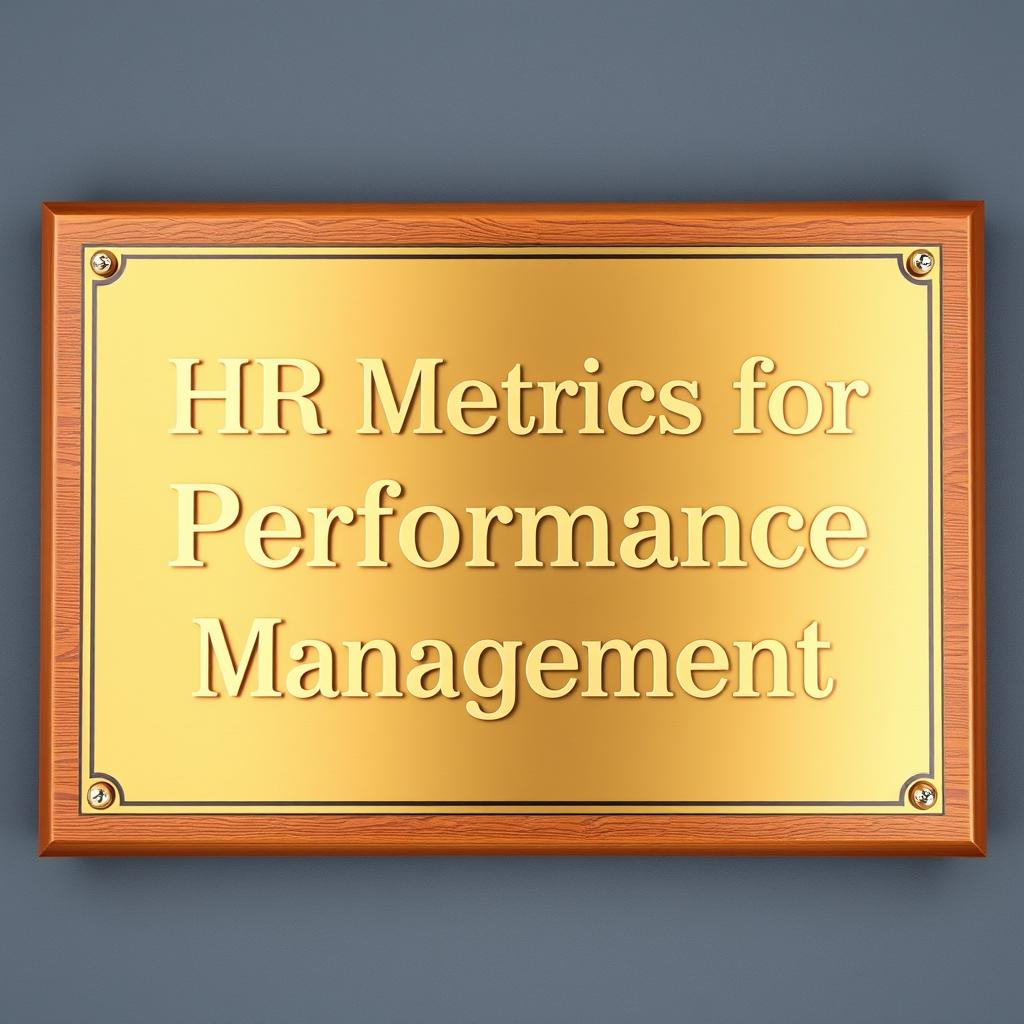Unlocking Potential: The Power of HR
Metrics for Performance Management

In today's fast-paced business world, the traditional approach to performance management — often characterized by annual reviews, subjective feedback, and a lack of real-time insight — is proving increasingly inadequate. Organizations are constantly searching for ways to foster a high-performing culture, develop talent effectively, and make strategic decisions that truly impact the bottom line. This is where HR metrics for performance management step in as a game-changer. If you're looking to move beyond gut feelings and anecdotal evidence, and instead harness the power of data to drive human capital strategies, then understanding and implementing HR metrics is your next crucial step. This article will introduce you to the world of HR metrics, explore why they are essential for modern performance management, and detail the specific types of metrics that can transform how you nurture and evaluate your workforce.
What Exactly Are HR Metrics?

At its core, an HR metric is a measurable value used to track and assess the performance of your human resources department and the overall effectiveness of your people strategies. Think of them as the data points that tell the story of your workforce. While general business metrics might track sales figures or profit margins, HR metrics specifically focus on human capital—everything from employee engagement and retention to training effectiveness and productivity. They provide concrete, quantifiable data that allows you to identify trends, predict outcomes, and make informed decisions that align with your organizational goals. Instead of simply feeling like a training program was successful, HR metrics allow you to prove its impact on employee skills or performance.
The Paradigm Shift: From Gut Feeling to Data-Driven
Decisions

For too long, human resources has been perceived as a "soft" department, relying heavily on intuition and general observations. Performance reviews often suffered from recency bias, manager subjectivity, or a lack of objective evidence, leading to employee dissatisfaction, perceived unfairness, and ultimately, ineffective talent development. This reliance on anecdote rather than analytics can obscure critical issues, delay necessary interventions, and prevent organizations from identifying their top performers or areas ripe for improvement.
The shift towards HR metrics for performance management marks a fundamental change. It’s about bringing the same rigor and analytical precision that you apply to financial or operational data to your most valuable asset: your people. By quantifying aspects of employee performance, engagement, and development, you gain an objective lens through which to view your workforce. This enables you to pinpoint exactly what’s working, what isn’t, and most importantly, why. It transforms performance conversations from subjective debates into data-backed discussions focused on growth and improvement.
Why You Need HR Metrics for Performance Management

Implementing HR metrics for performance management offers a wealth of benefits that extend far beyond simply tracking numbers. It fundamentally changes how you understand, manage, and empower your employees.
Enhanced Objectivity and Fairness: Metrics provide an impartial basis for evaluating performance. When you assess employees based on clear, measurable data – such as goal attainment rates, project completion times, or quality scores – you reduce bias and ensure a more transparent and equitable process. This builds trust and confidence among your workforce, knowing their performance is judged on verifiable facts.
Proactive Problem Solving: HR metrics serve as an early warning system. By continuously monitoring key indicators, you can identify declining performance, rising absenteeism, or dips in engagement before they escalate into significant problems. This allows for timely interventions, coaching, or adjustments to strategies, preventing minor issues from becoming major setbacks.
Targeted Talent Development: Understanding where employees excel and where they struggle, based on data, allows for highly customized development plans. You can identify specific skill gaps across teams or individuals and invest in training programs that genuinely address those needs, maximizing your return on investment in talent development. This is a critical aspect when leveraging HR metrics for performance management.
Improved Employee Engagement and Retention: Engaged employees are productive employees. Metrics related to engagement, feedback, and career progression can reveal patterns that indicate employee satisfaction or dissatisfaction. Addressing these insights with data-driven strategies can significantly boost morale, improve retention rates, and cultivate a more positive work environment.
Strategic Alignment: By connecting individual and team performance metrics directly to organizational goals, you ensure that everyone is pulling in the same direction. This allows you to evaluate how effectively your human capital contributes to strategic objectives, making HR a more integral and influential partner in business strategy. This strategic linkage is a powerful outcome of effectively using HR metrics for performance management.
Key HR Metrics for Performance Management: What to
Measure

To effectively leverage HR metrics for performance management, you need to know which metrics are most impactful. Here's a breakdown of effective metrics, categorized for clarity:
Individual Performance Metrics
These metrics focus on an employee's contributions and development. They provide objective data points that can be integrated into performance reviews, development plans, and compensation decisions.
Goal Attainment Rate: This measures the percentage of assigned goals that an employee successfully achieves within a given timeframe. It's a direct indicator of effectiveness in meeting objectives. For instance, if you set 10 key performance indicators (KPIs) for a quarter, this metric tracks how many were met.
Quality of Work (e.g., Error Rates, Customer Satisfaction Scores): For roles where quality is paramount, tracking errors, defects, or customer feedback scores (e.g., Net Promoter Score for customer service reps) provides concrete evidence of performance quality.
Productivity Metrics (e.g., Output per Hour/Day, Sales Volume): Depending on the role, this could involve tracking units produced, lines of code written, calls handled, or sales generated. These metrics offer a quantifiable measure of efficiency and output.
Training Completion and Effectiveness: Tracks not just whether employees complete required training but, more importantly, assesses the actual impact of that training on their skills or job performance through post-training assessments or observable changes in work quality.
360-Degree Feedback Scores: While qualitative, these can be quantified into scores, providing a holistic view of an employee's performance from peers, direct reports, and supervisors, offering insights into collaboration, leadership, and soft skills. These qualitative insights, when aggregated and analyzed, become powerful HR metrics for performance management.
Team Performance Metrics
These metrics assess the collective efficiency and effectiveness of groups working together.
Team Project Success Rate: Measures the percentage of team projects completed on time, within budget, and meeting predefined quality standards.
Internal Collaboration Scores: Derived from surveys or feedback, these scores can indicate how effectively team members communicate, support each other, and resolve conflicts.
Project Completion Time vs. Estimated Time: Compares the actual time taken to complete a project against the initial estimate, highlighting areas for process improvement or better resource allocation.
Organizational/Systemic Metrics
These metrics provide a broader view, indicating the overall health of your workforce and the impact of your HR strategies. These are foundational when you implement HR metrics for performance management at scale.
Employee Turnover Rate (especially Voluntary Turnover): A high voluntary turnover rate can signal issues with management, compensation, culture, or career development opportunities. Tracking this metric helps identify underlying problems impacting overall performance.
Absenteeism Rate: High absenteeism can indicate disengagement, stress, or a poor work environment, all of which negatively impact productivity and team morale.
Employee Engagement Scores: Regular surveys can quantify how connected, motivated, and committed your employees are to their work and the organization. Engaged employees are significantly more productive.
Internal Promotion Rate: This metric reflects the organization's ability to develop talent from within and provides career growth opportunities, which is a key driver of retention and motivation.
Time to Productivity for New Hires: Measures how long it takes for new employees to become fully productive, indicating the effectiveness of your onboarding and initial training programs.
Return on Investment (ROI) of Training Programs: Quantifies the financial benefit derived from training initiatives compared to their cost, ensuring that development efforts are truly impactful. This is a critical financial metric often overlooked when discussing HR metrics for performance management.
How to Implement and Utilize HR Metrics for Performance
Management

Introducing HR metrics for performance management into your organization requires a structured approach:
Define Clear Objectives: Before you start measuring, determine what specific questions you want to answer or what problems you want to solve. Are you looking to reduce turnover, improve productivity, or enhance engagement?
Choose Relevant Metrics: Don't try to measure everything. Select a few key metrics that directly align with your objectives and provide actionable insights. Start small and expand as you gain confidence.
Ensure Data Accuracy and Accessibility: Implement robust systems for collecting and storing HR data. Accuracy is paramount for reliable insights. Make sure the data is accessible to those who need it, in an easy-to-understand format.
Communicate Transparently: Explain to your employees why you are collecting these metrics and how they will be used. Emphasize that the goal is improvement and growth, not just surveillance. This transparency is key to the success of HR metrics for performance management.
Integrate with Performance Reviews: Use the collected data as a foundation for performance discussions. Instead of subjective critiques, managers can present objective evidence and work collaboratively with employees on improvement plans.
Act on Insights: Collecting data is only half the battle. The real value comes from analyzing the metrics and taking concrete action. If absenteeism is rising, investigate the causes and implement solutions. If a training program shows low ROI, adjust its content or delivery. This action-oriented approach defines effective HR metrics for performance management.
Overcoming Challenges
While the benefits are clear, implementing HR metrics for performance management can present challenges. You might encounter data overload, privacy concerns, or resistance to change from employees and managers accustomed to traditional methods. Address these by starting with a pilot program, ensuring data security, and providing training and clear communication on the "why" behind the shift. Emphasize that these metrics are tools for empowerment and strategic growth, benefiting everyone involved.
Conclusion
The journey towards a truly data-driven approach in HR is not merely about adopting new software; it's about fostering a culture where evidence, not just intuition, guides your most critical people decisions. By embracing HR metrics for performance management, you empower your organization to make more objective evaluations, foster talent more effectively, and build a more engaged and productive workforce. You're not just measuring performance; you're actively shaping it, transforming potential into tangible results, and ensuring that every investment in human capital delivers maximum impact. It's time to unlock the full potential of your people, one data point at a time.